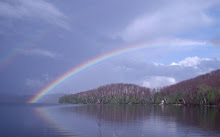 The bucket of scrap clay just before mixing. Into the bucket goes all scraps, the slurry water from the splash pan and the water from my little bucket I use when at the potter's wheel. Nothing goes down the drain! Note the clumps of clay just under the water line.
The bucket of scrap clay just before mixing. Into the bucket goes all scraps, the slurry water from the splash pan and the water from my little bucket I use when at the potter's wheel. Nothing goes down the drain! Note the clumps of clay just under the water line. It's messy, but necessary. I can't imagine throwing out clay that can this easily be recycled. I recycle about 200 lbs of clay each year!
It's messy, but necessary. I can't imagine throwing out clay that can this easily be recycled. I recycle about 200 lbs of clay each year! After a few minutes the clay is smooth like chocolate cake batter and ready to pour, but this is one mixer I will NOT be licking clean.
After a few minutes the clay is smooth like chocolate cake batter and ready to pour, but this is one mixer I will NOT be licking clean. This is the plaster slab I use for drying the clay. The clay is not completely dried, however. The plaster draws the moisture out of clay. I remove the clay from the plaster when it's a good consistency for wedging (kneading), cut it into smaller pieces and bag it.
This is the plaster slab I use for drying the clay. The clay is not completely dried, however. The plaster draws the moisture out of clay. I remove the clay from the plaster when it's a good consistency for wedging (kneading), cut it into smaller pieces and bag it. I use a jug or a ladel to scoop the clay out of the bucket and onto the plaster slab.
I use a jug or a ladel to scoop the clay out of the bucket and onto the plaster slab. I smooth out the clay and make it a consistent thickness on the plaster slab. Once bagged the clay sits for a year or so to "age." Clay I recycled in the spring of 2007 is now being used in the studio.
I smooth out the clay and make it a consistent thickness on the plaster slab. Once bagged the clay sits for a year or so to "age." Clay I recycled in the spring of 2007 is now being used in the studio.
Aah, the 3rd "R" is reduce! Not only do I recycle my clay, but I have also reduced the amount of water I use in the process by emptying my slurry and throwing water into my scrap clay bucket. I've also effectively reduced the amount of fuel used to transport the clay to my home because I'm transporting nothing. It's all happening right here! As a result of the recycling I order clay only once a year. I also re-use the plastic bags that the clay comes in from the manufacturer - a Canadian company - Plainsman clays.

 David Leach (England 1911-2005)
David Leach (England 1911-2005) 

 Covered Cheese Dish - an inside view.
Covered Cheese Dish - an inside view.
 Textured jug. 24 cm x 14 cm. Stoneware.
Textured jug. 24 cm x 14 cm. Stoneware. 
 Here is a teapot done in oatmeal flanked by my DaisyWare glazed in VCAA Blue.
Here is a teapot done in oatmeal flanked by my DaisyWare glazed in VCAA Blue. Plate detail. Handbuilt slab plate with stamped design. Stamp made by artist.
Plate detail. Handbuilt slab plate with stamped design. Stamp made by artist. Sunrise Salutations - 1999. Sculpture in porcelain. 28 cm x 10 cm.
Sunrise Salutations - 1999. Sculpture in porcelain. 28 cm x 10 cm.





